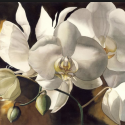
You’ve seen them, and maybe even have been gifted them: Philanopsis, otherwise known as orchids. They are stunningly gorgeous for a few weeks and if you’re lucky, for a few months. If you’re anything like me, not all that gifted with plants, you marvel that such rare and exotic beings live alongside you, effortlessly esteeming your aesthetic, and ultimately mourn that temporary exaltation as the slow procession of dying petals reminds you of your inability to keep them or anything forever.
I once bought a towering beauty and took her home, where she stayed flowering for three and a half months! Then friends gifted me with another smaller, yet no less stunning, plant for my birthday a few months later. These two beautiful creatures sat side by side, poised and luscious, around a small fountain in the kitchen.
Within time, both lost their flowers and instead of inconspicuously burying them in the garden, I decided I would see about reviving their blooms. I’d heard it was possible, so I moved them to the kitchen windowsill where they sat for months. It was around the third month when I first noticed a change.
Before describing what I saw, I’m sure there are at least several of you who would have enough experience to explain what I’m about to to tell you. Due to my inexperience and fascination with observation, the Phenomenologist in me might still stay convinced that she witnessed a rare event.
During that third month, a small tendril began to stick out of the smaller plant. A skilled plant grower friend said, “Oh! You’re going to get some new branches on this one! Possibly flowers!”
With that, my motivation blossomed. I sprayed both plants almost every day and within about a month, the small tendril, which I’ll add was not growing where I had expected it, at the bottom, near the moss it was planted in, but out of the original stem, about half the way up, sprouted into new little leaves. I thought, “wow, what are leaves doing way up there?” It looked as though it was growing a new anchor, but seemingly from the middle of its body. After the new little leaves grew, two new roots sprouted right beneath them, again, way up high!
As the smaller plant seemingly recreated itself, the larger, older plant’s leaves all started turning yellow and dying. One by one they yellowed and dropped to the ground. What was strange was, although the larger, older plant was dropping its leaves, looking like it coming to the end of its life, it was simultaneously sprouting new branches. In my thinking, it would need leaves to trap sunlight if any further growth was to happen, but sure enough, after every leaf had died, the branches continued growing. What furthered my amazement, was not only were the branches growing at a solid rate, but they weren’t growing up! They were growing sideways towards the smaller plant and starting to bud with the promise of new flowers!
I couldn’t help but wonder why one plant, who had just dropped its leaves, would start growing branches and flowering and aim right towards another plant who had grown new roots and leaves midway up itself? Did they suddenly think they were the same plant?
To the rational being, logic would say, “that’s impossible”! Yet, here it was—happeneing. As weeks went on, the small plant grew leaves and roots and the large one grew stems and flowers. Each reached towards the other, making their relationship undeniable. One morning I said out loud, “I’ll bet if I were to separate these two, their growth would stop”. But lacking the heart to interrupt their almost certain interdependency, I didn’t.
What was this symbiotic relationship modelling? I thought for weeks about what these two were implying about social and structural organization. I thought of how younger children learn from older children about how to go about being children. I thought about Morphic Resonance and how Rupert Sheldrake explains that “like species take cues in the form of resonance from the members of its species that came before them for how to grow, the more recent being the most influential. Or how in Indigenous terms we’re on the receiving end from our Ancestors, who come before us and have paved the way by learning some things so we don’t have to. But these examples were not quite the same as what was happening. (And I had thought of all of them before). What was I seeing that I had never seen before? After thinking for a bit, I realized the plants demonstrated a sort of individualism-bashing scenario that made me see that one being doesn’t have to have it all. That neighbouring beings, if by some small miracle, can relate enough, might carry each other.
I wonder if it was possible that I had unecessary judgement about two beings not being able to live without the other? I wonder now if single organisms actually would never grow beyond their present capacities if it weren’t for the augmentation of true partnership.
If there’s any truth in what emerged in my mind after observing the conversation between these two generous beings, then why would I or anyone want to choose a life nourished exclusively through our own talents? Or a lifestyle that boasts a list of individuated acts we have done for ourself? For the lifelong individualist, this is possibly a challenging, but ultimately relieving proposition—not having to have it all. For the habitual dependent person, it might be reinforcing and comforting. But I think these plants were not indulging the others’ independence or dependence, but somehow exemplified a more reverent gesture—devotion to the ceremonial act of life making life. I’ve found that love is like that, true friendship is like that, and ceremony is like that.
May we wonder together about how to make more of life like that.

